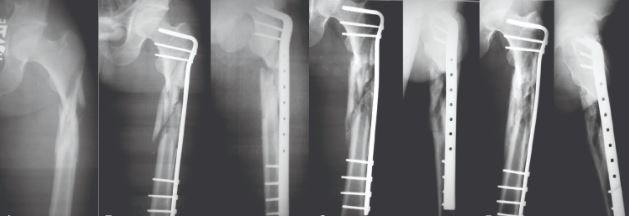In a few words…
Osteosynthesis is a surgical operation which consists in holding between them the fragments of a broken bone, thanks to metallic materials tolerated by the body and of a shape adapted to the treated element.

This operation is carried out when the reduction of the “fracture” focus (putting the bone fragments face to face) cannot be done by external maneuvers or when instability persists.
THE CONTEXT OF OSTEOSYNTHESIS
It is a surgical operation under general anesthesia. It will therefore sometimes take a few hours to wait until the stomach is empty.
Meanwhile, a splint or immobilization by traction is put in place, and the pain is relieved by an infusion of analgesics.
INDICATIONS
This intervention is reserved for several cases:
- Fractures that are too complex from the start, which cannot be reduced by external maneuvers. The surgeon must intervene to fix the bone fragments and allow good consolidation.
- Fractures that cannot remain stable under a cast.
Non-union (absence of bone consolidation).
THE VARIOUS TECHNIQUES OF OSTEOSYNTHESIS
Nailing:
A rod of suitable morphology is inserted into the central canal of a long bone (the tibia for example).
By forming a thread, nailing with a bore can sometimes even avoid rotation in the fracture site.
Increasing use is made of locked nailing (placement at the ends of the screw bone passed perpendicularly through the nail) which allows better stability of the “fractured” focus.
Screws and plates:
They are used if there is a risk of rotation that would offset the axis of the underlying joints, or for short bones. There are a variety of plates and screws of suitable shapes, allowing to fix all this in good position.
The screws are used for all the small bones, and to fix the plates.
The plates are reserved for long bones, for example over the entire length of the bone when it is short enough: this is the case of the clavicle where molded plates are used. Another case: the areas close to the joints.
The external fixator:
When the fractures are too complex and allow no direct fixation, the surgeon places an external fixator: it is composed of 2 metal bars on each side of the limb segment concerned, connected by rods which pass through the fractured bone, there where possible, and which hold the largest bone fragments to restore a correct bone axis.
There are empty spaces between the small fragments, which are gradually filled with a callus. The overall shape of the bone will be respected, as close as possible to the initial anatomy.
In non-union (absence of bone consolidation after fracture):
Compression screwing systems are used, interposing bone grafts so that living and solid bone is reconstituted.
